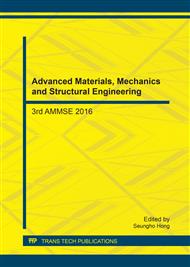[1]
M. P. Cartmell, A. J. Żak, O. A. Ganilova. Applications for shape memory alloys in structural and machine dynamics, Nonlinear Dynamic Phenomena in Mechanics. Springer Netherlands, 2012: 115-158.
DOI: 10.1007/978-94-007-2473-0_3
Google Scholar
[2]
F. Yutaka, H. Takayuki, D. Fengzhi, Fundamental research on polymer material as artificial muscle. Artif. Life Robot. 12(1-2) (2012) 232-235.
Google Scholar
[3]
Y. Bar-Cohen. Electroactive polymers as artificial muscles-reality and challenges, Proceedings of the 42nd AIAA Structures, Structural Dynamics, and Materials Conference (SDM), Gossamer Spacecraft Forum (GSF), held in Seattle WA, April 16-19 (2001).
DOI: 10.2514/6.2001-1492
Google Scholar
[4]
N. A. Stakhin: Electrostriction in dielectrics and metals. Russian Phys. J. (1998).
Google Scholar
[5]
V. M. Bogomol'nyi, Calculation of the electrostriction effect in thin-film metal-ferroelectric-metal structures. Tech. Phys. (1999).
DOI: 10.1134/1.1259362
Google Scholar
[6]
G. Kloos, Magnetostatic Maxwell stresses and magnetostriction. Electr. Eng. (1998).
Google Scholar
[7]
G. Kloos, The dependence of electrostatic stresses at the surface of a dielectric on its orientation in an electric field. J. Phys. D: Appl. Phys. 28 (1995) 2424-2429.
DOI: 10.1088/0022-3727/28/12/006
Google Scholar
[8]
G. Todd, O. Ben, A. A. Iain, Touch Sensitive Dielectric Elastomer Artificial Muscles. Electroact. Polym. Mater. Springer US (2012) pp.131-141.
Google Scholar
[9]
J. D. Nam, H. R. Choi, J. C. Koo, Y. K. Lee, K. J. Kim, Dielectric Elastomers for Artificial Muscles. Electroact. Polym. Robot. Appl. Springer London, (2007), pp.37-48.
Google Scholar
[10]
Y. Bar-Cohen, Electroactive Polymer (EAP) Actuators as Artificial Muscles-Reality, Potential and Challenges, Vol. PM136, SPIE-Society of Photo-optical Instrumentation Engineers, Bellingham, WA (2004).
DOI: 10.1117/3.547465
Google Scholar
[11]
G. Kofod, P. Sommer-Larsen, R. Kornbluh, R. Pelrine, Actuation response of polyacrylate dielectric elastomers. J. Intell. Mater. Syst. Struct. 14(12) (2003) 787–793.
DOI: 10.1177/104538903039260
Google Scholar
[12]
G. Kofod, P. Sommer-Larsen, Silicone dielectric elastomer actuators: finite-elasticity model of actuation. Sens. Actuators. A: Phys. 122(2) (2005) 273–283.
DOI: 10.1016/j.sna.2005.05.001
Google Scholar
[13]
R. Baughman, L. Shacklett, R. Elsenbaumer, Conducting polymer electromechanical actuator. Kluwer Academic, Dordrecht, 1990, p.559–582.
Google Scholar
[14]
Y. Bar-Cohen, Electroactive polymer (EAP) actuators as artificial muscles. SPIE (2004), p.529–581.
DOI: 10.1117/12.538698
Google Scholar
[15]
J. Hayashida, F. Dai, Y. Fujihara, Fundamental study of dielectric elastomer as artificial muscle. Proceedings of the 11th International Symposium on Artificial Life and Robotics (AROB, CD version, Oita, Japan, Jan. 23–25, 2006, pp.611-614.
Google Scholar


